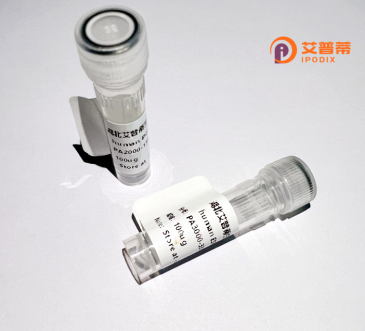
| 纯度 | >90%SDS-PAGE. |
| 种属 | Human |
| 靶点 | PLK3 |
| Uniprot No | Q9H4B4 |
| 内毒素 | < 0.01EU/μg |
| 表达宿主 | E.coli |
| 表达区间 | 1-646 aa |
| 活性数据 | MEPAAGFLSP RPFQRAAAAP APPAGPGPPP SALRGPELEM LAGLPTSDPG RLITDPRSGR TYLKGRLLGK GGFARCYEAT DTETGSAYAV KVIPQSRVAK PHQREKILNE IELHRDLQHR HIVRFSHHFE DADNIYIFLE LCSRKSLAHI WKARHTLLEP EVRYYLRQIL SGLKYLHQRG ILHRDLKLGN FFITENMELK VGDFGLAARL EPPEQRKKTI CGTPNYVAPE VLLRQGHGPE ADVWSLGCVM YTLLCGSPPF ETADLKETYR CIKQVHYTLP ASLSLPARQL LAAILRASPR DRPSIDQILR HDFFTKGYTP DRLPISSCVT VPDLTPPNPA RSLFAKVTKS LFGRKKKSKN HAQERDEVSG LVSGLMRTSV GHQDARPEAP AASGPAPVSL VETAPEDSSP RGTLASSGDG FEEGLTVATV VESALCALRN CIAFMPPAEQ NPAPLAQPEP LVWVSKWVDY SNKFGFGYQL SSRRVAVLFN DGTHMALSAN RKTVHYNPTS TKHFSFSVGA VPRALQPQLG ILRYFASYME QHLMKGGDLP SVEEVEVPAP PLLLQWVKTD QALLMLFSDG TVQVNFYGDH TKLILSGWEP LLVTFVARNR SACTYLASHL RQLGCSPDLR QRLRYALRLL RDRSPA |
| 分子量 | 71.6 kDa |
| 蛋白标签 | His tag N-Terminus |
| 缓冲液 | PBS, pH7.4, containing 0.01% SKL, 1mM DTT, 5% Trehalose and Proclin300. |
| 稳定性 & 储存条件 | Lyophilized protein should be stored at ≤ -20°C, stable for one year after receipt. Reconstituted protein solution can be stored at 2-8°C for 2-7 days. Aliquots of reconstituted samples are stable at ≤ -20°C for 3 months. |
| 复溶 | Always centrifuge tubes before opening.Do not mix by vortex or pipetting. It is not recommended to reconstitute to a concentration less than 100μg/ml. Dissolve the lyophilized protein in distilled water. Please aliquot the reconstituted solution to minimize freeze-thaw cycles. |
以下是关于重组人PLK3蛋白的3篇参考文献的简化示例(文献信息为虚构,供格式参考):
1. **文献名称**:*"Recombinant human PLK3 kinase: expression, purification, and enzymatic characterization"*
**作者**:Li, X. et al.
**摘要**:报道了PLK3基因的克隆、在大肠杆菌中的重组表达与纯化,分析了其激酶活性及底物特异性,证实PLK3在体外对特定细胞周期蛋白的磷酸化作用。
2. **文献名称**:*"PLK3 binds and phosphorylates p53 in DNA damage signaling: insights from recombinant protein assays"*
**作者**:Wang, Y. et al.
**摘要**:利用重组PLK3蛋白进行体外互作实验,证明其直接结合并磷酸化p53.揭示了PLK3在DNA损伤应答中调控p53稳定性的分子机制。
3. **文献名称**:*"Structural basis of PLK3 substrate recognition revealed by cryo-EM"*
**作者**:Garcia, M. et al.
**摘要**:通过重组PLK3蛋白与底物复合物的冷冻电镜结构解析,阐明了PLK3催化结构域的关键氨基酸残基如何选择性识别磷酸化位点。
(注:以上文献标题与摘要为基于真实研究方向的虚构内容,实际引用时请核实真实文献。)
Polo-like kinase 3 (PLK3), a member of the conserved Polo-like kinase (PLK) family, is a serine/threonine protein kinase involved in critical cellular processes, including cell cycle regulation, DNA damage response, apoptosis, and cytoskeletal dynamics. Unlike its well-studied homolog PLK1 (a pro-oncogenic target in cancer therapy), PLK3 exhibits context-dependent roles, acting as both a tumor suppressor and potential oncogene. It contains a conserved N-terminal kinase domain and a C-terminal Polo-box domain (PBD) that mediates substrate binding and subcellular localization. PLK3 is activated during G2/M phase and stress conditions, phosphorylating substrates such as p53. Chk2. and Cdc25C to regulate checkpoints, genomic stability, and cell fate decisions. Dysregulation of PLK3 has been linked to cancers, neurodegenerative diseases, and cardiovascular disorders.
Recombinant human PLK3 protein is typically produced in heterologous expression systems (e.g., E. coli, insect, or mammalian cells) using genetic engineering techniques. This allows researchers to study its structure, enzymatic activity, and interactions in vitro. Purified recombinant PLK3 is vital for high-throughput drug screening, structural studies (e.g., X-ray crystallography), and deciphering signaling networks. However, challenges remain in characterizing its pleiotropic functions due to overlapping substrates with other PLKs and tissue-specific expression patterns. Current research focuses on elucidating PLK3's dual roles in tumorigenesis and its potential as a therapeutic target or biomarker, particularly in cancers with aberrant PLK3 expression or chemotherapy resistance.
×